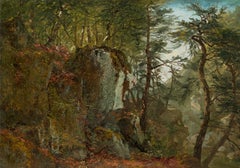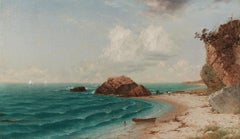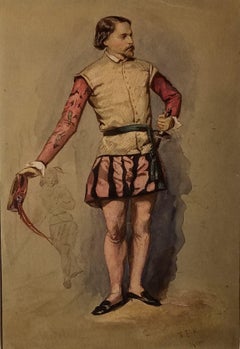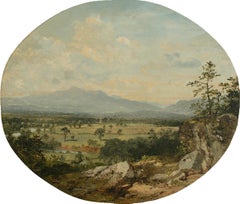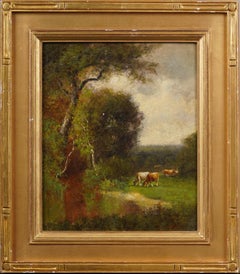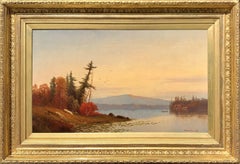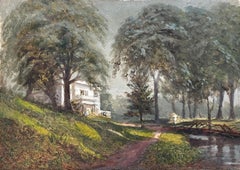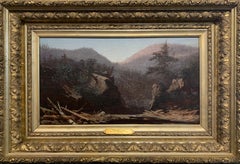John Frederick Kensett Paintings
to
2
1
1
Overall Width
to
Overall Height
to
4
3
1
1
1
1
1
1
1
1
1
1
1
1
1
1
1
1
1
1
4
3
2
2
1
4
783
707
701
699
3
4
Artist: John Frederick Kensett
Wooded Landscape with Boulders
By John Frederick Kensett
Located in New York, NY
In his oil painting titled, “Wooded Landscape with Boulders,” John Frederick Kensett depicts a rocky outcropping in a dense forest, with the slope of a mountain behind.
Category
Mid-19th Century John Frederick Kensett Paintings
Materials
Canvas, Oil
New England Coastal Scene with Figures
By John Frederick Kensett
Located in New York, NY
Monogramed and dated lower right: JF.K. / ‘64.
Category
Mid-19th Century Hudson River School John Frederick Kensett Paintings
Materials
Canvas, Oil
"Portrait of an Italian Fencer, " John Frederick Kensett, Hudson River School
By John Frederick Kensett
Located in New York, NY
John Frederick Kensett (1816 - 1872)
Portrait of an Italian Fencer, circa 1845-47
Watercolor on wove paper
13 1/8 x 8 1/8 inches
Signed with initials and inscribed lower right "J.F.K. Rome"
From October 1845 through the spring of 1847, Kensett lived in Rome. He attended classes where he sketched from live models, and he sketched in the countryside outside Rome and around Florence, Perugia, and Venice, places he visited with his artist friends. He fulfilled commissions for paintings from Americans in Italy, and by 1847 his career was well established.
Son of an English immigrant engraver, John Kensett lacked enthusiasm for that medium and became one of the most accomplished painters of the second generation of Hudson River School painters. His reputation is for Luminism, careful depiction of light, weather, and atmosphere as they affect color and texture of natural forms. He was particularly influenced by the painting of Asher Durand in that he focused on realism and detail rather than the highly dramatic views associated with Thomas Cole. Going to the western United States in the mid 1850s and the 1860s, he was the first of the Hudson River School painters to explore and paint the West.
Kensett was born and raised in Cheshire, Connecticut, and learned his engraving from his father, Thomas Kensett with whom he worked in New Haven, Connecticut until 1829. He continued working until 1840 as an engraver of labels, banknotes and maps and was employed part of that time by the American Bank Note Company in New York City. There he met Thomas Rossiter, John Casilear, and other artists who urged him to pursue painting. In 1840, he and Rossiter, Asher Durand, and Casilear went to Europe where Kensett stayed for seven years and supported himself by doing engraving but became accomplished in landscape painting.
Having sent canvases of Italian landscapes back to New York, he had a reputation for skillful painting that preceded him. When he returned to New York City in 1847, he was an "instant success" and very sought after by collectors. Two of his Italian landscapes had already been purchased by the American Art Union. By 1849, he was a full member of the National Academy of Design and was generally popular among his peers. His studio was a gathering place with travelers stopping by to see his canvases and to identify "precise locations in the Catskills or Newport or New England in the oil sketches and drawings that covered his walls." (Zellman 170). For the women, he was a popular bachelor, "romantic looking with high forehead and sensitive expression." (Samuels 262)
He was also sought after by many organizations. Among his activities were serving on the committee to oversee the decoration of the United States Capitol in Washington DC, and becoming one of the founders of the Metropolitan Museum in New York.
An inveterate traveler, Kensett spent summers on painting excursions away from New York City. One of these trips was a special painting excursion with fifteen other artists sponsored by the B & O Railroad from Baltimore, Maryland to Wheeling, West Virginia. Unlike many of the Hudson River painters...
Category
1840s Hudson River School John Frederick Kensett Paintings
Materials
Paper, Watercolor
Mount Chocorua
By John Frederick Kensett
Located in New York, NY
Leading Hudson River School Painter Famous for New England Views.
Category
19th Century Hudson River School John Frederick Kensett Paintings
Materials
Oil
Related Items
Antique American Hudson River School Cows Grazing Signed Framed Oil Painting
By William Hart
Located in Buffalo, NY
Incredible early American Hudson River School landscape painting by William Hart (1823 - 1894). Oil on board. Framed. Signed. Measuring 15 by 17 inches overall and image size, 1...
Category
1870s Hudson River School John Frederick Kensett Paintings
Materials
Oil, Board
$1,820 Sale Price
20% Off
H 15 in W 17 in D 2 in
Sunset on the Hudson River by Hermann Simon (American, 1846-1895)
Located in New York, NY
Painted by Hudson River School artist Hermann Simon (1846-1895) , "Sunset on the Hudson River" is oil on canvas, measures 15 x 25 inches, and is signed and dated 1875 at the lower ri...
Category
19th Century Hudson River School John Frederick Kensett Paintings
Materials
Canvas, Oil
$15,000
H 15 in W 25 in
1946 "Untitled" oil on canvas painting signed and dated by artist Alex Katz.
By Alex Katz
Located in Boca Raton, FL
"Untitled" oil on canvas painting by artist Alex Katz. Signed and dated A. Katz 46 recto lower right. Painted in 1946, during the period when Katz was studying at Cooper Union in New...
Category
1940s Modern John Frederick Kensett Paintings
Materials
Canvas, Oil
Antique Hudson River School Framed Coastal Luminous Seascape Oil Painting
Located in Buffalo, NY
Antique American Hudson River School coastal seascape. Most likely a view of Maine. Oil on board. Image size, 8 by 12 inches.
Category
1870s Hudson River School John Frederick Kensett Paintings
Materials
Canvas, Oil
$2,780 Sale Price
20% Off
H 20 in W 17 in D 2 in
Antique American 19th Century Forest Pond Interior Landscape Framed Oil Painting
Located in Buffalo, NY
Nicely framed 19th century forest interior landscape painting. Oil on canvas. Ready to hang. Image size, 13"L by 17"H inches painting alone.
Category
1880s Hudson River School John Frederick Kensett Paintings
Materials
Canvas, Oil
$780 Sale Price
20% Off
H 22 in W 18 in D 2 in
Dusk Forest Scene, Catskills by Lockwood DeForest (American, 1850-1932)
Located in New York, NY
"Dusk Forest Scene, Catskills," 1875 by Hudson River School painter Lockwood DeForest (American, 1850-1932) is oil on artists card-stock and measures 9.5 x 7 inches. The work is signed by DeForest, and dated May 13, 1875 at lower right. The work is framed in an elegant, period appropriate frame, and ready to hang.
Lockwood de Forest was born in New York in 1850 to a prominent family. He grew up in Greenwich Village and on Long Island at the family summer estate in Cold Spring Harbor. As was customary for a cultivated family in the Gilded Age, the de Forests made frequent trips abroad. Excursions to the great museums, which were prominent on the de Forests agenda, deepened the young Lockwood's familiarity with European painting and sculpture. Though he had begun drawing and painting somewhat earlier, it was during a visit to Rome in 1868 that nineteen-year-old de Forest first began to study art seriously, taking painting lessons from the Italian landscapist Hermann David Salomon Corrodi (1844–1905). More importantly, on the same trip, Lockwood met one of America’s most celebrated painters, (and his maternal great-
uncle by marriage) Frederic Edwin Church (1826–1900), who quickly became his mentor. DeForest accompanied Church on sketching trips around Italy and continued this practice when they both returned to America in 1869. Early on in his career, de Forest made a habit of recording the date and often the place of his oil sketches, as to create a visual diary of his travels. Lockwood’s profession as a landscape painter can be primarily attributed to Frederic E. Church and his belief in the young artist’s talent.
De Forest often visited Church in the Hudson River community of Catskill where, in addition to sketching trips and afternoons of painting, he assisted with the architectural drawings and planning of Olana. In 1872, de Forest took a studio at the Tenth Street Studio Building in New York. During these formative years de Forest counted among his friend’s artists such as Sanford Robinson Gifford (1823–80), George Henry Yewell (1830–1923), John Frederick Kensett (1816–72), Jervis McEntee (1828–91), and Walter Launt Palmer (1854–1932).
Over the next decade de Forest experienced success as a painter. He exhibited for the first time at the National Academy of Design in 1872, and made two more painting trips abroad, in 1875–76 and 1877–78, traveling to the major continental capitals but also the Middle East and North Africa. His trip to the Middle East and the library at Church’s home, Olana, established his interest in design during his mid-twenties. From about 1878 to 1902, landscape painting was overshadowed by his activities and preoccupation with East Indian architecture and décor, a style that became quite fashionable in late nineteenth century America. From 1879-1883, de Forest founded Associated Artists along with Louis Comfort Tiffany, Candace Wheeler...
Category
19th Century Hudson River School John Frederick Kensett Paintings
Materials
Oil, Board
Baldassarre Franceschini, Sleeping Cupid, Valentine's Day Gift
Located in Harkstead, GB
A beautiful 19th century copy by Giuseppe Rocchi of Baldassarre Franceschini's Sleeping Cupid, presented in a very attractive gilt frame with hand carved mouldings. A very peaceful i...
Category
Mid-19th Century Old Masters John Frederick Kensett Paintings
Materials
Paper, Watercolor
$1,303 Sale Price
20% Off
H 12 in W 8 in D 2.25 in
Hudson River Landscape by American Artist Johann Hermann Carmiencke (1810-1867)
By Johann Hermann Carmiencke
Located in New York, NY
Painted by Hudson River School artist Johann Hermann Carmiencke, "Hudson River Landscape" is oil on canvas and measures 12 x 18 inches. The painting is signed and dated 1865 at the l...
Category
19th Century Hudson River School John Frederick Kensett Paintings
Materials
Canvas, Oil
Antique American Hudson River School Landscape Cows Oil Painting Gilt Frame 19th
Located in Buffalo, NY
Antique Quintessential American Hudson River School landscape by an unknown Hudson River School artist.
This painting features its original period gold frame, and a charming scene o...
Category
1860s Hudson River School John Frederick Kensett Paintings
Materials
Canvas, Oil
$1,872 Sale Price
41% Off
H 20 in W 26 in
Antique American Hudson River School Sunset Landscape Monogrammed Oil Painting
Located in Buffalo, NY
Antique American Hudson River School landscape oil painting. Oil on board. Framed. Signed in monogram. Measuring: 17 by 25 inches overall, and 14 by 22 painting alone. In excellent...
Category
1880s Hudson River School John Frederick Kensett Paintings
Materials
Oil, Board
$1,750
H 25 in W 17 in D 2 in
"Countryside Landscape" Impressionist Oil Painting Canvas of Figure on Pathway
Located in New York, NY
A stunning oil painting depicting a serene countryside landscape with a figure walking along a winding path cutting through lush greenery. Tall, slender trees with sparse foliage in ...
Category
20th Century American Impressionist John Frederick Kensett Paintings
Materials
Canvas, Oil
$3,000
H 30.25 in W 42.25 in D 2 in
Hudson River School Large American Impressionist Landscape Wisconsin in the Snow
Located in Cotignac, FR
A large scale American Hudson River School Impressionist landscape of a snow scene, most probably Wisconsin, by Leroy Ferdinand Jonas. The painting is signed and dated bottom right and presented in a fine gilt frame.
An imposing view of a snowy landscape most probably the artist's native Wisconsin. Jonas has captured the grandeur of the scene with the contrast between the thick lush snow and the rich colours of the foliage and leaves on the trees. His impasto technique is very characteristic of the American Impressionists as is the subject and sense of scale. A really beautiful painting which because of its scale would be a statement piece in any room.
LeRoy Jonas was born in the town of Texas, Marathon County, Wisconsin, on April 18, 1897, son of Johann F. and Marie (Borchardt) Jonas. He was educated in Wausau public schools and attended the Chicago Art Institute, where he studied under John Norton, noted for his murals, Leopold Seifert, noted for his portraits, and William Wilmovsky, a landscape artist. He worked as a commercial artist and Conservator of Fine Arts there. Upon graduating, he painted for a while in Door County, Wisconsin and was then awarded a scholarship to study under Leon Lundmark...
Category
Early 20th Century Hudson River School John Frederick Kensett Paintings
Materials
Canvas, Oil
$1,416 Sale Price
50% Off
H 34.65 in W 41.34 in D 1.78 in
Previously Available Items
"White House and Trees, " John Frederick Kensett, Hudson River School, New Jersey
By John Frederick Kensett
Located in New York, NY
John Frederick Kensett
White House and Trees, circa 1853
Oil and gouache on paper
6 3/4 x 9 3/4 inches
Provenance:
Estate of Vincent Colyer (1824 - 1888)
By descent
Paul Magriel Collection
Private Collection, Long Island
Exhibited:
New York, The Finch College Museum of Art; Southampton, New York, The Parrish Art Museum; New Orleans, Louisiana, Isaac Delgado Museum of Art; Norfolk, Virginia, Norfolk Museum of Art; Montclair, New Jersey, Montclair Art Museum; New London, Connecticut, Lyman Allyn Museum; Manchester, New Hampshire, The Currier Gallery of Art; Providence, Rhode Island, Rhode Island School of Design; Youngstown, Ohio, The Butler Institute of American Art, American Drawings (Benjamin West to the present) from the Paul Magriel Collection, June 1961 - December 1962.
Portland, Oregon, Portland Art Museum, April 14 - May 15, 1963.
Boston International Fine Art Show at the Cyclorama, Lincoln Glenn, October 19 - 23, 2022.
In the 1850s through 1860, John Frederick Kensett, painted a series of at least five landscapes of the "Shrewsbury River" (now the Navesink River) along the New Jersey shore. Art historians have described Kensett’s paintings of the river as having evolved from a trip in the fall of 1853 at the invitation of Kensett's friend, author and lecturer George Curtis. However, letters viewable at the Smithsonian Archives of American Art website make it clear that Kensett had become acquainted with the area over a year earlier, most likely in connection with fellow artist and friend Thomas Prichard Rossiter.
Kensett and Rossiter had been friends since at least the 1830s. As aspiring artists, they had traveled to Europe together in the 1840s. In 1851 Rossiter married Anna Ehrick Parmly, then in her early 20s, and Kensett attended the wedding. Anna was one of four daughters of Eleazer and Anna Maria Parmly. Eleazer, one of the major figures in American dentistry history, was a wealthy and accomplished member of New York society.
When not in the city, the Parmly family gathered at Bingham Place, a sprawling estate on 275 pastoral acres spanning the peninsula between the Shrewsbury and Navesink Rivers along the New Jersey shore. The Bingham Place estate encompassed much of what is now Rumson, then known as Oceanic, N.J. It was a wide-open landscape of ocean views, orchards, lawns, and cattle-dotted pastures. There the Parmlys opened their doors to family, friends, and the summer breeze.
Rossiter, newly-married into the Parmly family, was likely the reason that Kensett paid a social visit to Bingham Place in the summer of 1852. On July 11, 1852, having reluctantly departed, Kensett wrote Rossiter who was still at Bingham Place:
New York to me now is that of a deserted place…marking a dismal contrast to the green lawns at Bingham Place. I saw the receding shores of Shrewsbury & the line of dust which marked your homeward course & finally the last glimpse of the Locust trees that shade the pleasant mansion & happy inmates at Bingham with any thing but a joyous spirit.
A major figure in the American luminist tradition and one of the most renowned painters of the Civil War era, John Frederick Kensett was born in Cheshire, Connecticut, in 1816. He was the son of Thomas Kensett, a British immigrant engraver, and it was in his father's New Haven firm that Kensett first learned to draw.
After mastering the rudiments of the graphic arts, he worked as an engraver in print shops in New Haven, Albany, and New York throughout the 1830's. During this period, he began to paint on his own, encouraged by a friend and fellow artist, John W. Casilear. In 1838, he made his first submission, a landscape, to the annual exhibitions of the National Academy of Design.
Desirous of continuing his training, Kensett traveled to Europe in 1840. For the next seven years, often in the company of artists such as Casilear and Asher B...
Category
1850s Hudson River School John Frederick Kensett Paintings
Materials
Paper, Oil
Kaaterskill Falls, New York, Hudson River School Landscape, Signed and Framed
By John Frederick Kensett
Located in Doylestown, PA
"Kaaterskill Falls" is a 9" x 16" oil on canvas landscape by Hudson River School and luminist painter John Frederick Kensett. The painting is framed and monogrammed in the lower left...
Category
Mid-19th Century Hudson River School John Frederick Kensett Paintings
Materials
Canvas, Oil
John Frederick Kensett paintings for sale on 1stDibs.
Find a wide variety of authentic John Frederick Kensett paintings available for sale on 1stDibs. You can also browse by medium to find art by John Frederick Kensett in paint, oil paint, canvas and more. Not every interior allows for large John Frederick Kensett paintings, so small editions measuring 10 inches across are available. Customers who are interested in this artist might also find the work of Jasper Francis Cropsey, William Rickarby Miller, and William Bradford. John Frederick Kensett paintings prices can differ depending upon medium, time period and other attributes. On 1stDibs, the price for these items starts at $10,000 and tops out at $450,000, while the average work can sell for $87,500.
